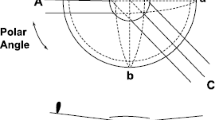Abstract
The plasma instrumentation (PLS) for the Galileo Mission comprises a nested set of four spherical-plate electrostatic analyzers and three miniature, magnetic mass spectrometers. The three-dimensional velocity distributions of positive ions and electrons, separately, are determined for the energy-per-unit charge (E/Q) range of 0.9 V to 52 kV. A large fraction of the 4π-steradian solid angle for charged particle velocity vectors is sampled by means of the fan-shaped field-of-view of 160°, multiple sensors, and the rotation of the spacecraft spinning section. The fields-of-view of the three mass spectrometers are respectively directed perpendicular and nearly parallel and anti-parallel to the spin axis of the spacecraft. These mass spectrometers are used to identify the composition of the positive ion plasmas, e.g., H+, O+, Na+, and S+, in the Jovian magnetosphere. The energy range of these three mass spectrometers is dependent upon the species. The maximum temporal resolutions of the instrument for determining the energy (E/Q) spectra of charged particles and mass (M/Q) composition of positive ion plasmas are 0.5 s. Three-dimensional velocity distributions of electrons and positive ions require a minimum sampling time of 20 s, which is slightly longer than the spacecraft rotation period. The two instrument microprocessors provide the capability of inflight implementation of operational modes by ground-command that are tailored for specific plasma regimes, e.g., magnetosheath, plasma sheet, cold and hot tori, and satellite wakes, and that can be improved upon as acquired knowledge increases during the tour of the Jovian magnetosphere. Because the instrument is specifically designed for measurements in the environs of Jupiter with the advantages of previous surveys with the Voyager spacecraft, first determinations of many plasma phenomena can be expected. These observational objectives include field-aligned currents, three-dimensional ion bulk flows, pickup ions from the Galilean satellites, the spatial distribution of plasmas throughout most of the magnetosphere and including the magnetotail, and ion and electron flows to and from the Jovian ionosphere.
Similar content being viewed by others
References
Bagenal, F.: 1985, ‘Plasma Conditions Inside Io's Orbit: Voyager Measurements’, J. Geophys. Res. 90, 311.
Bagenal, F., McNutt, R. L., Jr., Belcher, J. W., Bridge, H. S., and Sullivan, J. D.: 1985, ‘Revised Ion Temperatures for Voyager Plasma Measurements in the Io Plasma Torus’, J. Geophys. Res. 90, 1755.
Baker, D. N. and Van Allen, J. A.: 1976, ‘Energetic Electrons in the Jovian Magnetosphere’, J. Geophys. Res. 81, 617.
Belcher, J. W.: 1983, in A. J. Dessler (ed.), ‘The Low-Energy Plasma in the Jovian Magnetosphere’, Physics of the Jovian Magnetosphere, Cambridge University Press, Cambridge, p. 68.
Frank, L. A., Ackerson, K. L., Wolfe, J. H., and Mihalov, J. D.: 1976, ‘Observations of Plasmas in the Jovian Magnetosphere’, J. Geophys. Res. 81, 457.
Gurnett, D. A. and Scarf, F. L.: 1983, in A. J. Dessler (ed.), ‘Plasma Waves in the Jovian Magnetosphere’, Physics of the Jovian Magnetosphere, Cambridge University Press, Cambridge, p. 285.
Krimigis, S. M. and Roelof, E. C.: 1983, in A. J. Dessler (ed.), ‘Low-Energy Particle Population’, Physics of the Jovian Magnetosphere, Cambridge University Press, Cambridge., p. 106.
Sands, M. R. and McNutt, R. L., Jr.: 1988, ‘Plasma Bulk Flow in Jupiter's Dayside Middle Magnetosphere’, J. Geophys. Res. 93, 8502.
Scudder, J. D., Sittler, E. C., Jr., and Bridge, H. S.: 1981, ‘A Survey of the Plasma Electron Environment of Jupiter: A View from Voyager’, J. Geophys. Res. 86, 8517.
Sittler, E. C. and Strobel, D. F.: 1987, ‘Io Plasma Torus Electrons: Voyager 1’, J. Geophys. Res. 92, 5741.
Van Allen, J. A.: 1976, in T. Gehrels (ed.), ‘High-Energy Particles in the Jovian Magnetosphere’, Jupiter, University of Arizona Press, Tucson, p. 928.
Vasyliunas, V. M.: 1983, in A. J. Dessler (ed.), ‘Plasma Distribution and Flow’, Physics of the Jovian Magnetosphere, Cambridge University Press, Cambridge, p. 395.
Author information
Authors and Affiliations
Rights and permissions
About this article
Cite this article
Frank, L.A., Ackerson, K.L., Lee, J.A. et al. The plasma instrumentation for the Galileo Mission. Space Sci Rev 60, 283–304 (1992). https://doi.org/10.1007/BF00216858
Issue Date:
DOI: https://doi.org/10.1007/BF00216858




